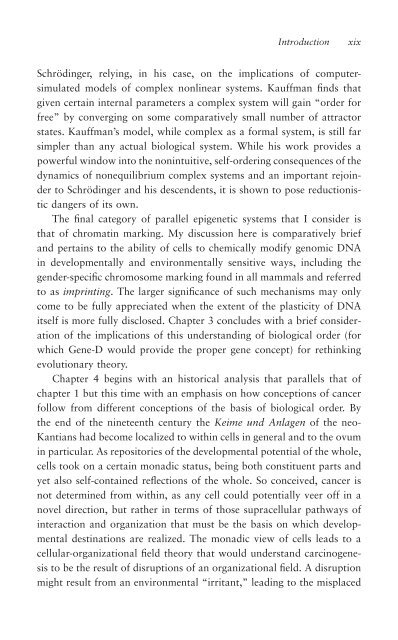A Critique of Pure (Genetic) Information
A Critique of Pure (Genetic) Information
A Critique of Pure (Genetic) Information
Create successful ePaper yourself
Turn your PDF publications into a flip-book with our unique Google optimized e-Paper software.
Introduction xix<br />
Schrödinger, relying, in his case, on the implications <strong>of</strong> computersimulated<br />
models <strong>of</strong> complex nonlinear systems. Kauffman finds that<br />
given certain internal parameters a complex system will gain “order for<br />
free” by converging on some comparatively small number <strong>of</strong> attractor<br />
states. Kauffman’s model, while complex as a formal system, is still far<br />
simpler than any actual biological system. While his work provides a<br />
powerful window into the nonintuitive, self-ordering consequences <strong>of</strong> the<br />
dynamics <strong>of</strong> nonequilibrium complex systems and an important rejoinder<br />
to Schrödinger and his descendents, it is shown to pose reductionistic<br />
dangers <strong>of</strong> its own.<br />
The final category <strong>of</strong> parallel epigenetic systems that I consider is<br />
that <strong>of</strong> chromatin marking. My discussion here is comparatively brief<br />
and pertains to the ability <strong>of</strong> cells to chemically modify genomic DNA<br />
in developmentally and environmentally sensitive ways, including the<br />
gender-specific chromosome marking found in all mammals and referred<br />
to as imprinting. The larger significance <strong>of</strong> such mechanisms may only<br />
come to be fully appreciated when the extent <strong>of</strong> the plasticity <strong>of</strong> DNA<br />
itself is more fully disclosed. Chapter 3 concludes with a brief consideration<br />
<strong>of</strong> the implications <strong>of</strong> this understanding <strong>of</strong> biological order (for<br />
which Gene-D would provide the proper gene concept) for rethinking<br />
evolutionary theory.<br />
Chapter 4 begins with an historical analysis that parallels that <strong>of</strong><br />
chapter 1 but this time with an emphasis on how conceptions <strong>of</strong> cancer<br />
follow from different conceptions <strong>of</strong> the basis <strong>of</strong> biological order. By<br />
the end <strong>of</strong> the nineteenth century the Keime und Anlagen <strong>of</strong> the neo-<br />
Kantians had become localized to within cells in general and to the ovum<br />
in particular. As repositories <strong>of</strong> the developmental potential <strong>of</strong> the whole,<br />
cells took on a certain monadic status, being both constituent parts and<br />
yet also self-contained reflections <strong>of</strong> the whole. So conceived, cancer is<br />
not determined from within, as any cell could potentially veer <strong>of</strong>f in a<br />
novel direction, but rather in terms <strong>of</strong> those supracellular pathways <strong>of</strong><br />
interaction and organization that must be the basis on which developmental<br />
destinations are realized. The monadic view <strong>of</strong> cells leads to a<br />
cellular-organizational field theory that would understand carcinogenesis<br />
to be the result <strong>of</strong> disruptions <strong>of</strong> an organizational field. A disruption<br />
might result from an environmental “irritant,” leading to the misplaced
















